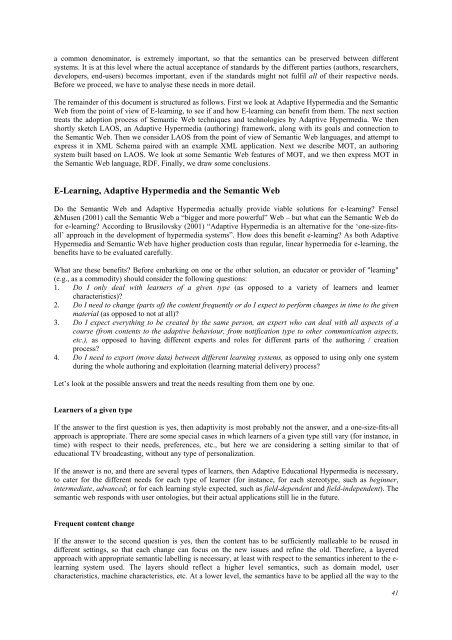Ontologies and the Semantic Web for E-learning - Educational ...
Ontologies and the Semantic Web for E-learning - Educational ...
Ontologies and the Semantic Web for E-learning - Educational ...
Create successful ePaper yourself
Turn your PDF publications into a flip-book with our unique Google optimized e-Paper software.
a common denominator, is extremely important, so that <strong>the</strong> semantics can be preserved between different<br />
systems. It is at this level where <strong>the</strong> actual acceptance of st<strong>and</strong>ards by <strong>the</strong> different parties (authors, researchers,<br />
developers, end-users) becomes important, even if <strong>the</strong> st<strong>and</strong>ards might not fulfil all of <strong>the</strong>ir respective needs.<br />
Be<strong>for</strong>e we proceed, we have to analyse <strong>the</strong>se needs in more detail.<br />
The remainder of this document is structured as follows. First we look at Adaptive Hypermedia <strong>and</strong> <strong>the</strong> <strong>Semantic</strong><br />
<strong>Web</strong> from <strong>the</strong> point of view of E-<strong>learning</strong>, to see if <strong>and</strong> how E-<strong>learning</strong> can benefit from <strong>the</strong>m. The next section<br />
treats <strong>the</strong> adoption process of <strong>Semantic</strong> <strong>Web</strong> techniques <strong>and</strong> technologies by Adaptive Hypermedia. We <strong>the</strong>n<br />
shortly sketch LAOS, an Adaptive Hypermedia (authoring) framework, along with its goals <strong>and</strong> connection to<br />
<strong>the</strong> <strong>Semantic</strong> <strong>Web</strong>. Then we consider LAOS from <strong>the</strong> point of view of <strong>Semantic</strong> <strong>Web</strong> languages, <strong>and</strong> attempt to<br />
express it in XML Schema paired with an example XML application. Next we describe MOT, an authoring<br />
system built based on LAOS. We look at some <strong>Semantic</strong> <strong>Web</strong> features of MOT, <strong>and</strong> we <strong>the</strong>n express MOT in<br />
<strong>the</strong> <strong>Semantic</strong> <strong>Web</strong> language, RDF. Finally, we draw some conclusions.<br />
E-Learning, Adaptive Hypermedia <strong>and</strong> <strong>the</strong> <strong>Semantic</strong> <strong>Web</strong><br />
Do <strong>the</strong> <strong>Semantic</strong> <strong>Web</strong> <strong>and</strong> Adaptive Hypermedia actually provide viable solutions <strong>for</strong> e-<strong>learning</strong>? Fensel<br />
&Musen (2001) call <strong>the</strong> <strong>Semantic</strong> <strong>Web</strong> a “bigger <strong>and</strong> more powerful” <strong>Web</strong> – but what can <strong>the</strong> <strong>Semantic</strong> <strong>Web</strong> do<br />
<strong>for</strong> e-<strong>learning</strong>? According to Brusilovsky (2001) “Adaptive Hypermedia is an alternative <strong>for</strong> <strong>the</strong> ‘one-size-fitsall’<br />
approach in <strong>the</strong> development of hypermedia systems”. How does this benefit e-<strong>learning</strong>? As both Adaptive<br />
Hypermedia <strong>and</strong> <strong>Semantic</strong> <strong>Web</strong> have higher production costs than regular, linear hypermedia <strong>for</strong> e-<strong>learning</strong>, <strong>the</strong><br />
benefits have to be evaluated carefully.<br />
What are <strong>the</strong>se benefits? Be<strong>for</strong>e embarking on one or <strong>the</strong> o<strong>the</strong>r solution, an educator or provider of "<strong>learning</strong>"<br />
(e.g., as a commodity) should consider <strong>the</strong> following questions:<br />
1. Do I only deal with learners of a given type (as opposed to a variety of learners <strong>and</strong> learner<br />
characteristics)?<br />
2. Do I need to change (parts of) <strong>the</strong> content frequently or do I expect to per<strong>for</strong>m changes in time to <strong>the</strong> given<br />
material (as opposed to not at all)?<br />
3. Do I expect everything to be created by <strong>the</strong> same person, an expert who can deal with all aspects of a<br />
course (from contents to <strong>the</strong> adaptive behaviour, from notification type to o<strong>the</strong>r communication aspects,<br />
etc.), as opposed to having different experts <strong>and</strong> roles <strong>for</strong> different parts of <strong>the</strong> authoring / creation<br />
process?<br />
4. Do I need to export (move data) between different <strong>learning</strong> systems, as opposed to using only one system<br />
during <strong>the</strong> whole authoring <strong>and</strong> exploitation (<strong>learning</strong> material delivery) process?<br />
Let’s look at <strong>the</strong> possible answers <strong>and</strong> treat <strong>the</strong> needs resulting from <strong>the</strong>m one by one.<br />
Learners of a given type<br />
If <strong>the</strong> answer to <strong>the</strong> first question is yes, <strong>the</strong>n adaptivity is most probably not <strong>the</strong> answer, <strong>and</strong> a one-size-fits-all<br />
approach is appropriate. There are some special cases in which learners of a given type still vary (<strong>for</strong> instance, in<br />
time) with respect to <strong>the</strong>ir needs, preferences, etc., but here we are considering a setting similar to that of<br />
educational TV broadcasting, without any type of personalization.<br />
If <strong>the</strong> answer is no, <strong>and</strong> <strong>the</strong>re are several types of learners, <strong>the</strong>n Adaptive <strong>Educational</strong> Hypermedia is necessary,<br />
to cater <strong>for</strong> <strong>the</strong> different needs <strong>for</strong> each type of learner (<strong>for</strong> instance, <strong>for</strong> each stereotype, such as beginner,<br />
intermediate, advanced; or <strong>for</strong> each <strong>learning</strong> style expected, such as field-dependent <strong>and</strong> field-independent). The<br />
semantic web responds with user ontologies, but <strong>the</strong>ir actual applications still lie in <strong>the</strong> future.<br />
Frequent content change<br />
If <strong>the</strong> answer to <strong>the</strong> second question is yes, <strong>the</strong>n <strong>the</strong> content has to be sufficiently malleable to be reused in<br />
different settings, so that each change can focus on <strong>the</strong> new issues <strong>and</strong> refine <strong>the</strong> old. There<strong>for</strong>e, a layered<br />
approach with appropriate semantic labelling is necessary, at least with respect to <strong>the</strong> semantics inherent to <strong>the</strong> e<strong>learning</strong><br />
system used. The layers should reflect a higher level semantics, such as domain model, user<br />
characteristics, machine characteristics, etc. At a lower level, <strong>the</strong> semantics have to be applied all <strong>the</strong> way to <strong>the</strong><br />
41
















